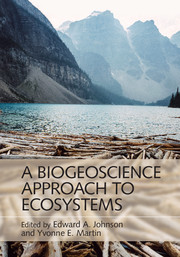Book contents
- Frontmatter
- Contents
- List of contributors
- Preface
- Miscellaneous Frontmatter
- 1 Introduction
- Part I Connecting Ecosystem and Geoscience Processes
- 2 Toward a General Scaling Theory for Linking Traits, Stoichiometry, and Body Size to Ecosystem Function
- Part II Transport Processes and Conservation Budgets in Biogeoscience
- Part III Coupling Hillslope Geomorphology, Soils, Hydrology, and Ecosystems
- Part IV Coupling Fluvial and Aeolian Geomorphology, Hydrology/Hydraulics, and Ecosystems
- Index
- References
2 - Toward a General Scaling Theory for Linking Traits, Stoichiometry, and Body Size to Ecosystem Function
from Part I - Connecting Ecosystem and Geoscience Processes
Published online by Cambridge University Press: 27 October 2016
- Frontmatter
- Contents
- List of contributors
- Preface
- Miscellaneous Frontmatter
- 1 Introduction
- Part I Connecting Ecosystem and Geoscience Processes
- 2 Toward a General Scaling Theory for Linking Traits, Stoichiometry, and Body Size to Ecosystem Function
- Part II Transport Processes and Conservation Budgets in Biogeoscience
- Part III Coupling Hillslope Geomorphology, Soils, Hydrology, and Ecosystems
- Part IV Coupling Fluvial and Aeolian Geomorphology, Hydrology/Hydraulics, and Ecosystems
- Index
- References
Summary
Introduction
[W]ithout theory, we have only phenomenology and correlation, and we lose the opportunity to yoke the complexity of ecological systems using simple, quantitative principles.
Marquet et al. (2014)Scaling has been heralded as one of the major challenges of ecology for more than two decades (Levin, 1992; Ehleringer and Field, 1993). Here, in the spirit of Marquet et al. (2014), we provide an overview of a general theory for scaling based on simple quantitative principles. We argue that a focus on scaling also presents some of the more powerful scientific tools available to ecologists facing problems that are unprecedented in both their scope and their stakes. Indeed, one of the central challenges of ecosystem science is to scale up from measurements on individual traits, organisms, and locations to predict the carbon and nutrient pools and fluxes of entire ecosystems.
In terrestrial ecosystems, this challenge requires us to integrate the physiological functioning of plants (e.g., leaf-level photosynthesis) across a collection of heterogeneous individuals (e.g., plants of different species) to understand the functioning of the entire ensemble (e.g., primary productivity) (Ehleringer and Field, 1993; Chapin, 2003). In order to better predict the future of plant communities and ecosystem functioning in response to rising CO2 and enhanced nitrogen (N) deposition with changes in climate (temperature and precipitation), this sort of understanding must be extended to connect simultaneous changes in multiple biogeochemical cycles.
Why a General Allometric and Metabolic Theory of Ecosystems Is Needed
Recent re-evaluations of global change models indicate that they could greatly benefit from incorporating allometry and ecosystem scaling. Specifically, global change models used to understand how ecosystems respond to climate change frequently do not produce realistic biomass and allometries, which suggests the need for better models of plant growth, nutrient uptake, and mortality (Wolf et al., 2011). Metabolic scaling provides a bridge between leaf-, plant-, and stand-level measurements and the biogeochemical and thermodynamic processes that drive global change models.
In this chapter, we focus on the powerful control that plant size and functional traits exert on ecosystem pattern and process. We use recent insights from the Metabolic Scaling Theory (MST) to scale up from individual plant metabolism, nutrient stoichiometry, and functional traits to ecosystem-level pools and fluxes.
Information
- Type
- Chapter
- Information
- A Biogeoscience Approach to Ecosystems , pp. 9 - 46Publisher: Cambridge University PressPrint publication year: 2016
References
Accessibility standard: Unknown
Why this information is here
This section outlines the accessibility features of this content - including support for screen readers, full keyboard navigation and high-contrast display options. This may not be relevant for you.Accessibility Information
- 8
- Cited by
